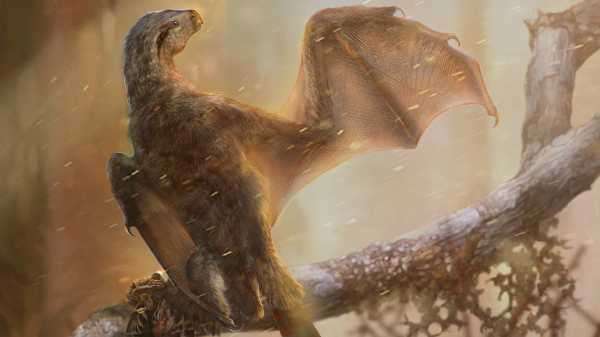
Life reconstruction of the bizarre Ambopteryx longibrachium, a small Jurassic dinosaur with membranous wings.
The world’s most diminutive dinosaur is … a hummingbird!
“Birds are just one lineage of dinosaurs that happened to survive to the present,” said Julia Clarke, a paleontologist at North Carolina State University and the North Carolina Museum of Natural Sciences.
.
As for the record holder of the world’s smallest extinct dinosaur, there are a few candidates.
In Mongolia’s Gobi Desert in 2007, Clarke and her colleagues discovered a 2-foot-long (70 centimeters) dinosaur, Mahakala omnogovae, which lived about 80 million years ago. Another dinosaur dating to the Cretaceous period (between 146 million and 65 million years ago), a tiny, thick-headed plant eater called Micropachycephalosaurus, also measured 2 feet (70 cm) in length.
And some dinosaurs were even smaller than that.
Yi qi, a feathered dinosaur from China with membranous wings like a bat’s, had a wingspan of 23 inches (60 cm) and weighed 13 ounces (380 grams). Recently, scientists described another bat-winged dinosaur that was a close relative of Yi qi — but smaller. This new discovery, found in northeastern China and named Ambopteryx longibrachium, measures 13 inches (32 cm) long and weighs about 11 ounces (306 grams), the researchers reported in May 2019 in the journal Nature.
And there are still more examples of diminutive dinos. Ashdown maniraptoran, measuring between 13 and 16 inches (33 and 50 cm) long, was one of the smallest extinct dinosaurs. So was Parvicursor (“slender runner”); found in Mongolia and dating to around 72 million years ago, it measures just 15 inches (38 cm) long and weighs fewer than 6 ounces (170 grams). And Eosinopteryx brevipenna, a flightless, feathered dinosaur from northeastern China, measures just under 12 inches (30 cm) long.
But sometimes, fossil size can be misleading. Bones belonging to a tiny dinosaur from Argentina, found in the 1970s, were so small that they prompted researchers to name the animal Mussaurus or “mouse lizard.” But later discoveries unveiled giant versions of this dinosaur! Scientists realized that they had first found fossils of a baby Mussaurus, and that the adults could weigh up to 250 lbs. (113 kilograms).
Another type of tiny dinosaur revealed its existence through footprints rather than fossils. In 2018, an international team of researchers found minuscule dinosaur tracks in South Korea’s Jinju Formation that dated to 110 million years ago; each footprint measured just 0.4 inches (1 cm) long. This means that the dinosaurs that left the tracks would have been no bigger than a sparrow, the researchers said in a statement.
However, it is unknown if those dinosaurs were mature adults or pint-size babies of a much bigger species, according to the statement.
Sourse: www.livescience.com





